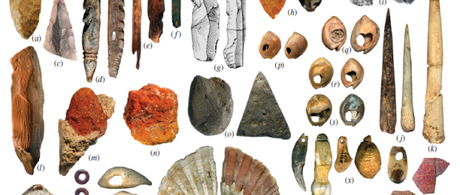
Chimp archaeology is a legitimate thing. It studies "ancient" chimp technology. Chimp archaeologists in Africa have discovered that this ancient chimp technology is the same as their "modern" tools. For the past 4,000 years chimps have been using the same sorts of rocks to crack the same sorts of nuts in the same sort of way. They even exploited the exact same tree for this time period (until it died). Human technology, on the other hand, has undergone drastic changes in the last 4,000 years. So what is it that drives our technological evolution. Why are we so advanced?
Anthropologists have been studying this issue for years. They've identified several key factors that influence the rate of technological evolution. Things like:
- Mobility. A group always on the move won't be able to carry around an extensive toolkit, limiting their technological capabilities and development.
- The number of different resources a group utilises. A broader diet will probably require the development of new tools in order to obtain the food.
- Risk of failure. If you're living a risky lifestyle then something going wrong can be pretty severe. This motivates people to come up with bigger and better technology in order to mitigate the chances of this happening.
All of these seem like fairly obvious factors that would influence technological evolution. However, researchers discovered there was another, underappreciated force at work: demography. Computer models suggested that population size had a surprisingly strong effect on technological development; with larger populations developing fancier tools faster.
The logic was that a larger population provides a larger pool of innovators and teachers. If more people are using a technology, it's more likely that someone will stumble across an improvement.
And it seems to line up against historical data as well. Around the time prehistoric human populations began to increase in size their technology also kicks up a gear. Meanwhile parts of the globe where our ancestors were small in number they didn't see such a significant change. In fact, in some areas where the population shrunk technology was even lost!
All the evidence seemed to point towards demography being a pretty key player in technological evolution. That is, until a group of researchers recently performed one of the biggest studies on the subject ever. Examining almost 50 hunter-gatherer groups from the 1800s to present day; they found there wasn't actually a correlation between population size and technological development.
Well, their results weren't that dramatic. They did find that demography played a role in technological evolution; but it was a relatively minor one. The other factors I listed off had a stronger influence on the rate technology developed. Risk of failure in particular was a very big driving force.
In other words, this is scientific proof that necessity is the mother of invention. When you absolutely must succeed because the risk and cost of failure is high; that's when we see technological evolution. Fear is the driver of innovation.
Boy, this research sounds pretty deep when you phrase it like that.
References
- Collard, M., Buchanan, B., & O'Brien, M. J. (2013). Population size as an explanation for patterns in the paleolithic archaeological record. Current Anthropology, 54(S8), S388-S396.
- Collard M, Ruttle A, Buchanan B, O'Brien MJ (2013) Population Size and Cultural Evolution in Nonindustrial Food-Producing Societies. PLoS ONE 8(9): e72628. doi:10.1371/journal.pone.0072628
- Kempe, M., & Mesoudi, A. (2014). An experimental demonstration of the effect of group size on cultural accumulation. Evolution and Human Behavior, 35(4), 285-290.

